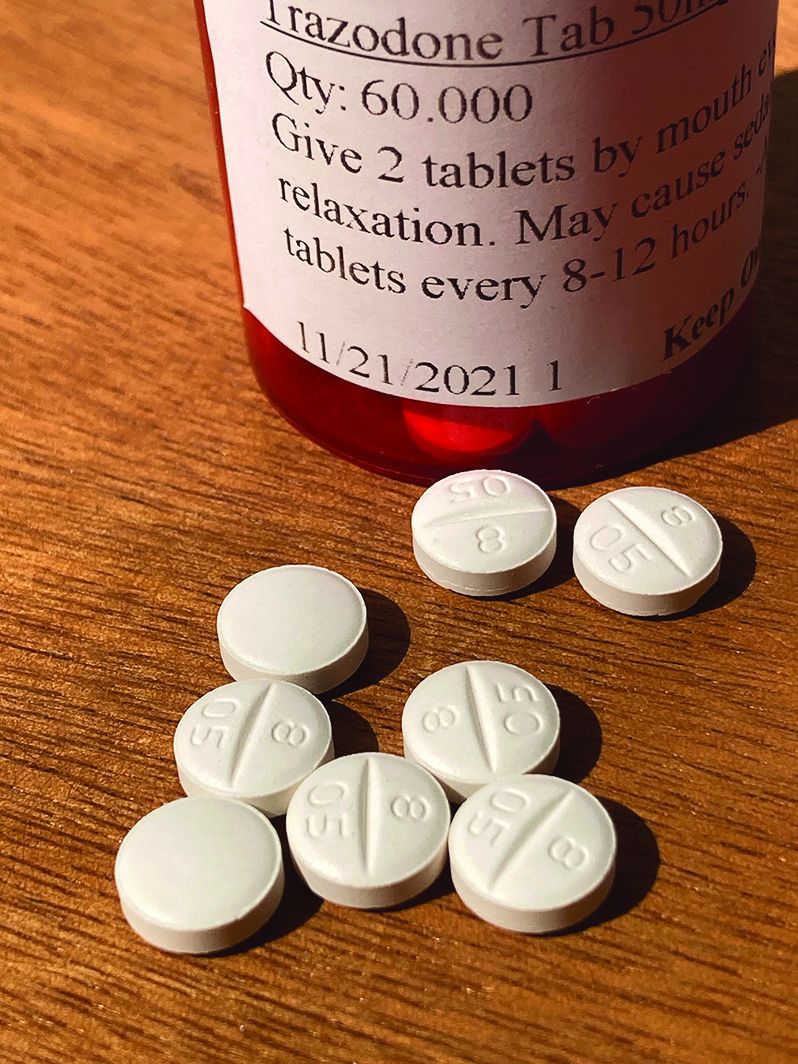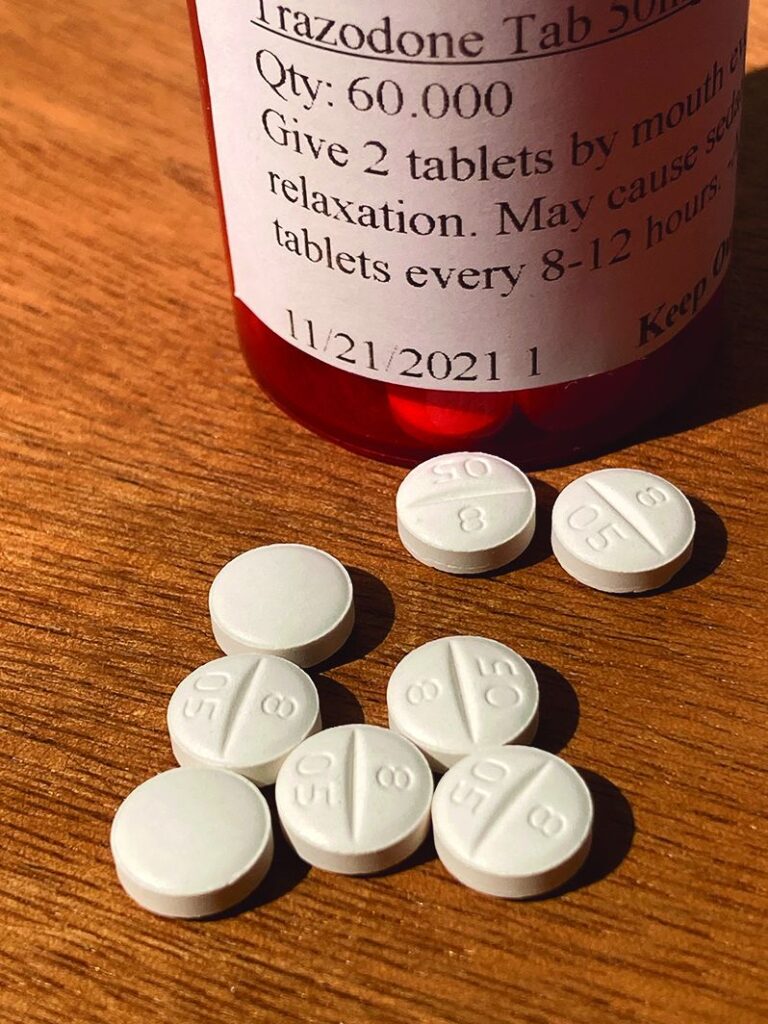Trazodone dosage for dogs typically ranges from 1.7 to 9.5 mg per pound of body weight, administered every 8 to 24 hours. Always consult your veterinarian for the precise dosage.
Table of Contents
Trazodone is a medication commonly used to manage anxiety and behavioral issues in dogs. This antidepressant helps calm dogs during stressful events like thunderstorms, vet visits, or travel. Veterinarians often prescribe it for short-term or long-term use, depending on the dog’s needs.
It is crucial to follow the vet’s guidelines to ensure your pet’s safety and well-being. The correct dosage varies based on the dog’s weight, health status, and specific needs. Monitoring for side effects, such as lethargy or gastrointestinal issues, is essential. Always seek veterinary advice before starting any new medication for your dog.


Introduction To Trazodone
Trazodone is a medication used to help dogs. It can treat anxiety and other issues. Many pet owners have found it helpful.
What Is Trazodone?
Trazodone is a type of antidepressant. It affects chemicals in the brain. These chemicals may be unbalanced in dogs with anxiety.
It is not only for humans. Vets also use it for dogs. It helps them relax and feel better.
Uses In Veterinary Medicine
Vets use Trazodone for many reasons. Below are some common uses:
- Reducing anxiety
- Helping with sleep problems
- Calming dogs before medical visits
- Treating behavioral issues
Vets prescribe different doses. This depends on the dog’s size and needs. Always follow the vet’s instructions for best results.


Why Trazodone For Dogs
Trazodone is a medication often prescribed for dogs. It helps manage their behavioral issues and anxiety. This makes life easier for both dogs and their owners.
Behavioral Issues
Many dogs suffer from behavioral problems. These can include aggression, excessive barking, or destructive chewing. Trazodone can help manage these issues. It works by affecting chemicals in the dog’s brain. This helps calm them down and reduce unwanted behaviors.
For example, a dog that chews furniture may benefit from trazodone. The medication can make the dog feel more relaxed. This leads to less destructive behavior. Vets often recommend trazodone for dogs with serious behavioral problems.
Anxiety Management
Dogs can experience anxiety just like humans. Common triggers include thunderstorms, fireworks, or being left alone. Trazodone can help manage this anxiety. It works as a sedative, making the dog feel calmer.
For instance, a dog that gets anxious during car rides may benefit. Trazodone helps the dog stay calm and relaxed. This makes the car ride less stressful for both the dog and the owner.
Here is a table showing common dosages for dogs:
| Weight of Dog (lbs) | Typical Dosage (mg) |
|---|---|
| 10-20 | 25-50 |
| 20-40 | 50-100 |
| 40-60 | 100-150 |
| 60-80 | 150-200 |
| 80-100 | 200-250 |
Always follow your vet’s advice on dosage. The vet will decide the best amount for your dog.
Determining The Right Dosage
Determining the right dosage of Trazodone for dogs is crucial. Administering the correct amount ensures safety and effectiveness. This section will guide you on how to determine the appropriate dosage.
Factors To Consider
Several factors influence the dosage of Trazodone for dogs. Understanding these ensures the best outcomes. Here are the key factors:
- Age: Older dogs may need lower doses.
- Health Condition: Dogs with liver or kidney issues require adjustments.
- Breed: Some breeds are more sensitive to medication.
- Current Medications: Interaction with other drugs can affect dosage.
- Severity of Symptoms: More severe symptoms might need higher doses.
Weight-based Calculations
Weight is a primary factor in determining Trazodone dosage. The dosage is typically calculated in milligrams per kilogram of body weight. Here’s a simple table to help:
| Dog’s Weight (kg) | Dosage (mg) |
|---|---|
| 5-10 kg | 25-50 mg |
| 10-20 kg | 50-100 mg |
| 20-30 kg | 100-150 mg |
| 30-40 kg | 150-200 mg |
It is crucial to start with the lowest possible dose. Gradually adjust based on your dog’s response.
Here’s a step-by-step guide to calculating the dosage:
- Weigh your dog accurately.
- Determine the dose in mg per kg (usually 2-5 mg/kg).
- Multiply your dog’s weight by the dose range.
- Administer the calculated dose and observe your dog.
Always consult your veterinarian before adjusting the dosage. They can provide guidance based on your dog’s specific needs.


Administering Trazodone
Administering Trazodone to your dog can help with anxiety and stress. It’s essential to follow the veterinarian’s guidelines. Proper administration ensures your dog benefits from the medication.
Forms Of Medication
Trazodone comes in various forms. The most common forms are:
- Tablets
- Capsules
- Liquid
The veterinarian will prescribe the best form for your dog. Tablets are often easy to use. Liquid forms are helpful for smaller dogs.
Tips For Administration
Follow these tips when giving Trazodone to your dog:
- Follow the prescription: Give the exact amount prescribed.
- Use a pill pocket: Hide the tablet in a treat.
- Mix with food: Crush the tablet and mix with wet food.
- Be consistent: Give the medication at the same time daily.
- Monitor your dog: Watch for any side effects.
These tips ensure your dog takes their medication safely. Always consult the vet if you notice any issues.
Potential Side Effects
While Trazodone can help dogs with anxiety, it may cause side effects. Knowing these side effects is important for your dog’s safety.
Common Reactions
Common side effects of Trazodone in dogs can include:
- Sleepiness: Your dog may sleep more than usual.
- Gastrointestinal Upset: Some dogs may vomit or have diarrhea.
- Increased Appetite: Your dog might feel hungrier.
- Dizziness: Your dog may seem unsteady or disoriented.
- Dry Mouth: You might notice your dog drinking more water.
When To Consult A Vet
Some side effects need urgent veterinary care:
- Severe Vomiting or Diarrhea: If it happens often, call your vet.
- Excessive Drooling: This could be a sign of a bad reaction.
- Restlessness: If your dog can’t settle down, consult your vet.
- Difficulty Breathing: Immediate vet attention is necessary.
- Seizures: This is an emergency. Visit your vet at once.
Always monitor your dog after giving Trazodone. Keep a close watch on any changes in behavior or health.
Monitoring Your Dog’s Response
Monitoring your dog’s response to trazodone is crucial. Observing changes helps ensure the dosage is effective and safe. Pay attention to behavior, mood, and physical signs.
Behavioral Changes
Watch for behavioral changes in your dog. Some changes might include increased calmness or reduced anxiety. Note any signs of lethargy or excessive sleepiness. Also, observe if your dog becomes more agitated or restless.
Below is a table summarizing common behavioral changes:
| Positive Changes | Negative Changes |
|---|---|
| Increased Calmness | Lethargy |
| Reduced Anxiety | Excessive Sleepiness |
| Improved Mood | Agitation |
Adjusting Dosage
Adjusting the dosage might be necessary based on your dog’s response. If positive changes are seen, the current dosage might be effective. If negative changes are observed, consult your vet.
Follow these steps for adjusting dosage:
- Observe your dog’s behavior for at least one week.
- Note any positive or negative changes.
- Contact your vet with your observations.
- Adjust the dosage only under veterinary guidance.
Remember, each dog is unique. What works for one might not work for another. Always prioritize your dog’s well-being.
Alternatives To Trazodone
Trazodone is commonly prescribed to dogs for anxiety and behavioral issues. While it can be effective, some pet owners seek alternatives. This can be due to side effects or personal preferences. There are several options available that can help manage your dog’s anxiety.
Other Medications
Several other medications might be suitable for your dog’s anxiety. Each has its benefits and potential side effects. Always consult your vet before changing medications.
| Medication | Uses | Side Effects |
|---|---|---|
| Clomipramine | Separation anxiety, obsessive-compulsive disorders | Vomiting, dry mouth, drowsiness |
| Fluoxetine | Anxiety, aggression, obsessive behaviors | Loss of appetite, lethargy, gastrointestinal upset |
| Alprazolam | Panic disorders, phobias | Sedation, coordination issues, increased appetite |
Natural Remedies
Natural remedies can also help manage your dog’s anxiety. These options may have fewer side effects and can be used alongside other treatments. Here are some popular natural remedies:
- CBD Oil: Helps with anxiety, pain, and inflammation. Start with a low dose.
- Herbal Supplements: Chamomile, valerian root, and passionflower can soothe anxiety.
- Essential Oils: Lavender and chamomile oils can create a calming environment.
- Calming Treats: Treats infused with calming herbs can reduce stress.
Consider these alternatives if you want a more natural approach. Always consult your vet before trying new treatments.
Frequently Asked Questions
What Is Trazodone Used For In Dogs?
Trazodone is used to treat anxiety and behavioral issues in dogs.
How Much Trazodone Should I Give My Dog?
The dosage depends on your dog’s weight and condition. Consult your vet for the correct dosage.
Is Trazodone Safe For Dogs?
Yes, trazodone is generally safe when prescribed by a vet. Always follow the vet’s instructions.
Can Trazodone Cause Side Effects In Dogs?
Yes, side effects can include sedation, lethargy, and gastrointestinal issues. Contact your vet if you notice any adverse effects.
How Long Does Trazodone Take To Work In Dogs?
Trazodone usually starts working within 1-2 hours. Its effects can last for several hours.
Conclusion
Understanding the correct trazodone dosage for dogs ensures their safety and well-being. Always consult your vet before administration. Proper dosage can help manage anxiety and stress effectively. Keep your furry friend happy and healthy by following professional advice. Stay informed and prioritize your pet’s health for a happier life together.


